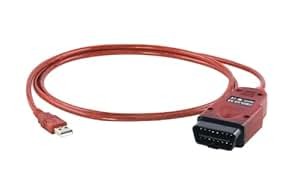For car enthusiasts and DIY mechanics, understanding your vehicle’s health is paramount. Obd2 Cables are essential tools in this process, acting as the vital link between your car’s computer and diagnostic software. If you’re looking to delve into car diagnostics, particularly for brands like BMW, selecting the correct OBD2 cable is your first crucial step. This guide will help you navigate the world of OBD2 cables and choose the best one for your needs.
Understanding OBD2 and the Importance of the Right Cable
OBD2 (On-Board Diagnostics II) is a standardized system that allows you to access your car’s computer and retrieve valuable information about its performance and potential issues. An OBD2 cable serves as the physical interface, connecting your car’s OBD2 port to a diagnostic device, often a laptop. However, not all OBD2 cables are created equal, and compatibility is key, especially when using specialized software like INPA for BMW vehicles.
Choosing the wrong cable can lead to frustration and an inability to communicate with your car’s systems. For BMWs, for example, a simple generic OBD2 cable might not unlock the full potential of diagnostic software like INPA or ISTA. These programs often require specific cable types like K+DCAN to fully access all modules and functions.
Key Considerations When Selecting an OBD2 Cable
When choosing an OBD2 cable, several factors come into play:
- Compatibility: Ensure the cable is compatible with your car’s make and model. For BMWs, research if a K+DCAN cable is necessary for the software you intend to use.
- Software Compatibility: Verify if the cable works seamlessly with your chosen diagnostic software. INPA and ISTA for BMWs often have specific cable requirements. Generic OBD2 software for basic code reading might be more flexible.
- Build Quality and Reliability: Opt for cables from reputable brands or sellers to ensure durability and stable communication. A poorly made cable can lead to connection issues and unreliable data.
- USB Interface: Most modern OBD2 cables connect to laptops via USB, offering a convenient and widely compatible interface.
OBD2 Cables for BMW Diagnostics: K+DCAN and Beyond
For in-depth BMW diagnostics, coding, and programming, a K+DCAN cable is frequently recommended. These cables are designed to work with BMW-specific software like INPA, ISTA, and other tools, unlocking advanced functionalities such as:
- Reading and clearing BMW-specific fault codes across all modules.
- Performing service functions like battery registration.
- Car coding and programming functionalities.
- Running activations for components like pumps.
While you might find cheaper OBD2 cables online, especially on platforms like eBay or Amazon, be cautious. Some may not be fully compatible with INPA or ISTA, or might lack the reliability needed for consistent diagnostics. Investing in a recommended K+DCAN cable from a trusted source, like BimmerGeeks, can save you time and hassle in the long run.
Entry-Level OBD2 Cable Options for Basic Diagnostics
If your needs are primarily for basic OBD2 functions like reading and clearing generic engine codes on various car brands, a more universal OBD2 cable like the OBDLink USB can be a suitable entry-level option.
 ScanTool OBDLink USB: Professional Grade OBD-II Automotive Scan Tool for Windows
ScanTool OBDLink USB: Professional Grade OBD-II Automotive Scan Tool for Windows
These cables are typically user-friendly and compatible with a wide range of OBD2 software. However, they generally lack the advanced BMW-specific functionalities offered by K+DCAN cables and software like INPA. They are excellent for general car maintenance and understanding basic engine health, but might not suffice for deeper BMW system analysis or programming.
Software is Key: Pairing Your OBD2 Cable with the Right Program
Remember that the OBD2 cable is only half the equation. Diagnostic software is equally crucial. For BMWs, INPA and ISTA are powerful tools, but they require compatible cables and can have a steeper learning curve. While some versions of INPA might be in German, English versions are available, ensuring accessibility for a wider range of users.
For basic OBD2 functions, numerous user-friendly software options exist, often compatible with generic OBD2 cables. Choosing software that aligns with your diagnostic needs and technical expertise is vital for effective car maintenance.
Conclusion: Choosing Wisely for Effective Car Diagnostics
Selecting the right OBD2 cable is a critical decision for anyone venturing into car diagnostics. Whether you’re a BMW owner seeking advanced system access or simply need to read basic engine codes, understanding your needs and the capabilities of different OBD2 cables is essential. For BMW-specific tasks and software like INPA and ISTA, a K+DCAN cable is often the preferred choice. For general OBD2 diagnostics across various car brands, entry-level cables like OBDLink USB offer a solid starting point. By considering compatibility, software requirements, and your diagnostic goals, you can choose an OBD2 cable that empowers you to understand and maintain your vehicle effectively.